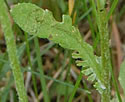Packera paupercula (Balsam Ragwort)
| Also known as: | Balsam Grounsel |
|---|---|
| Genus: | Packera |
| Family: | Asteraceae (Aster) |
| Life cycle: | perennial |
| Origin: | native |
| Habitat: | part shade, sun; rocky loamy soil; moist prairie, wet meadows, stream banks |
| Bloom season: | May - August |
| Plant height: | 6 to 18 inches |
| Wetland Indicator Status: | GP: FAC MW: FAC NCNE: FAC |
| MN county distribution (click map to enlarge): |  |
| National distribution (click map to enlarge): |  |
Pick an image for a larger view. See the glossary for icon descriptions.
Detailed Information
Flower: 

![[photo of flowers]](/udata/r9ndp23q/pd/packera-paupercula-88-17-t.jpg) A mostly erect cluster of up to 20 flowers that is more or less flat across the top in profile, the stalks long and slender, often all attached at the very tip of the stem, though occasionally a few stalks are forked. The flowers are about ¾ inch across, daisy-like with golden yellow centers and 0, 8 or 13 yellow rays (petals), the narrow floral bracts often tinged purple at the tip. Several scale-like bracts are usually widely spaced on the flower stalks.
A mostly erect cluster of up to 20 flowers that is more or less flat across the top in profile, the stalks long and slender, often all attached at the very tip of the stem, though occasionally a few stalks are forked. The flowers are about ¾ inch across, daisy-like with golden yellow centers and 0, 8 or 13 yellow rays (petals), the narrow floral bracts often tinged purple at the tip. Several scale-like bracts are usually widely spaced on the flower stalks.
Leaves and stems: 



![[photo of leaves]](/udata/r9ndp23q/yellow/balsam-ragwort_0627_152626-t.jpg) Leaves are simple, mostly basal, the lowest leaves are erect, oblong to round to spoon shape, 1 to 2½ inches long, about ½ inch wide, the blade about half as long as the slender stalk, with sharp teeth along the tip and sides and the base smoothly tapering to the stalk. Stem leaves are widely spaced, quickly become reduced in size, more lance-shaped, deeply lobed and stalkless, nearly clasping the stem.
Leaves are simple, mostly basal, the lowest leaves are erect, oblong to round to spoon shape, 1 to 2½ inches long, about ½ inch wide, the blade about half as long as the slender stalk, with sharp teeth along the tip and sides and the base smoothly tapering to the stalk. Stem leaves are widely spaced, quickly become reduced in size, more lance-shaped, deeply lobed and stalkless, nearly clasping the stem.
![[photo of stem leaf]](/udata/r9ndp23q/pd/packera-paupercula-8-t.jpg) Leaves may be smooth throughout, but often sparsely, fine woolly, especially in the leaf axils, the lower surface and even sparsely cobwebby on the upper leaves especially when young. Stems are unbranched, slender and typically smooth though short, fine wooly hairs may be present towards the base.
Leaves may be smooth throughout, but often sparsely, fine woolly, especially in the leaf axils, the lower surface and even sparsely cobwebby on the upper leaves especially when young. Stems are unbranched, slender and typically smooth though short, fine wooly hairs may be present towards the base.
Fruit: 
![[photo of fruit]](/udata/r9ndp23q/yellow/balsam-ragwort_0627_164723-t.jpg) Fruit is a small dandelion like plume of small brown seed with a tuft of swirled white hairs (pappus) to carry it off in the wind.
Fruit is a small dandelion like plume of small brown seed with a tuft of swirled white hairs (pappus) to carry it off in the wind.
Notes:
Balsam Ragwort, formerly Senecio pauperculus, is one of the 4 predominant Packera species native to Minnesota that are all similar in casual appearance. Its leaves and those of Prairie Ragwort (Packera plattensis) are of similar shape and size, but Prairie Ragwort is typically densely woolly hairy throughout, it inhabits dry, sandy prairie, and typically has flower clusters that are more branching.
Native Plant Nurseries, Restoration and Landscaping Services ↓
More photos
Photos by K. Chayka taken at Vadnais/Snail Lake Regional Park, Ramsey County. Photos courtesy Peter M. Dziuk taken in Aitkin, Anoka and Ramsey counties.
Comments
Have you seen this plant in Minnesota, or have any other comments about it?
on: 2015-06-05 11:57:20
On Highway 25 about 1/2 mile north of the Grant County Line (Highway 26). Nice big patch of them growing in the ditch.
on: 2020-06-15 12:43:49
Washington County; On St. Croix trail bordering Afton State Park. Photos of leaves and flowers available. Dry, rocky hillside
on: 2021-05-19 16:36:09
Saw a few plants along a wetland at Crow Hassan Park.







 Balsam Ragwort plants
Balsam Ragwort plants more plants
more plants more leaves
more leaves more flowers
more flowers garden-grown Balsam Ragwort
garden-grown Balsam Ragwort